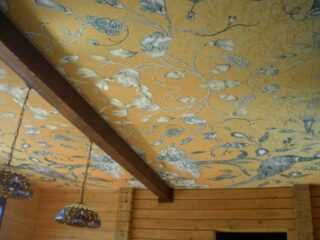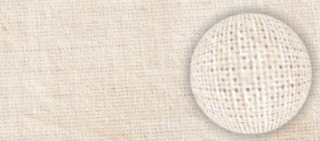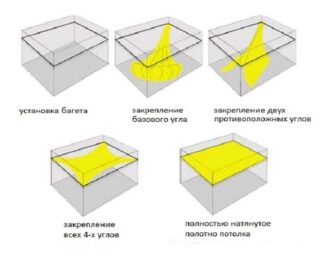Stretch ceiling structures are becoming more and more popular. They are easy to install, even in a room with finished wall and floor finishes. One of the options is to equip the fabric stretch ceiling with your own hands. Usually such coatings have a matte surface.
Advantages and disadvantages of fabric stretch ceiling

Installation of fabric stretch ceilings reduces the height of wall planes much less than the use of other stretch structures. Other advantages of such a system include:
- Seamless structure: roll material has a significant width (more than 5 m).
- Resistance to high temperature environments, allowing the use of such fabrics for attic decoration. Canvases and cold air tolerate well (up to -40 degrees). However, they do not become brittle and remain elastic. Such a ceiling can be installed in a room that is not equipped with a heating system.
- The presence of an impregnation that protects against contamination by mold and fungal pathogenic flora.
- Resistant to accidental mechanical damage. However, with a purposeful application of efforts, it is still possible to break through the canvas.
- When compared with PVC structures equipped with lighting devices, fabric canvases are good because there are no spots and irregularities in the places where the lamps are fixed.
- Impregnation with flame retardant compounds. This prevents the materials from spreading fire.
The fabric ceiling is suitable only for rooms with low air humidity. It is impossible to make such a structure in the bathroom, it will not be the best option for the kitchen either. Another limitation is the inability to reinstall the renewed fabric. The drawing will have to be created on a new canvas and then fixed instead of the dismantled old one.
Smoking in a room with a fabric ceiling is not worth it, as it tends to absorb tobacco smoke.
You need to mount the canvas solidly, without joints. Otherwise, to mask the overlap, you will need to purchase special overhead parts.
Varieties of materials
Before installing fabric stretch ceilings, you need to choose a suitable design. You can find canvases equipped with linings that neutralize the effect of echo and other acoustic phenomena. Such products are often purchased for recording studios and other acoustically demanding environments. Another modern development is translucent fabrics that allow you to design the ceiling in an unusual way using lamps installed above the level of the canvas. But if the appliances go out of order, the homeowner will not be able to remove the canvas and then reinstall it. Therefore, in this case, special attention is paid to the selection of lamps and the quality of the wiring.
Synthetic knitted fabrics

Polyester is most often used as a basis for such fabrics. Despite its synthetic nature, this material looks similar to wool. The interlacing of the threads is impregnated with polyurethane, which provides the finished product with some moisture resistance. The appearance of such canvases is always matte, without shine. However, their texture is sometimes performed as an imitation of other materials (chintz, suede).There are products that have two layers: a mesh bottom and an embossed top. Due to the characteristics of these fabrics, the finished ceiling looks expensive and respectable.
Rough unpainted coarse calico

This option is attractive to many for its low cost. However, it takes more time to prepare the base when installing such a stretch ceiling made of fabric with your own hands. This is due to the fact that the panels do not have a seamless structure, in contrast to special synthetic products. The homeowner will need to combine the strips in advance into a single composition corresponding to the dimensions of the room. Suture areas need to be treated. When the canvas is stretched, the fabric can be primed and painted with a compound designed for this task.
Required tools and materials
Before you can stretch the fabric ceiling, you will need to prepare equipment and tools.
If it is planned to install luminaires, the wiring must be laid in advance. It is also necessary to check its integrity.
Dowels and self-tapping screws are used as fasteners. The canvas is set into baguettes by means of a spatula with a rounded working area.
A regular knife is used to cut off tissue surplus. Marking is carried out with a level, a simple pencil and a ruler.
DIY instructions for installing a fabric stretch ceiling
Step-by-step instruction:
- Cover the pieces of furniture with polyethylene.
- The roll of canvas is unrolled and allowed to straighten for half an hour or an hour.
- If the ceiling surface is flat, make an indent of 15-20 mm and mark the tension line using a level. Nests for dowels are drilled along the perimeter, baguettes are mounted and fixed with self-tapping screws.
- When the fabric is straightened, you can install it. The corners are fixed with clothespins. If a partner is involved in holding the roll, clothespins may not be used.
- The filling of fabric into baguettes is carried out using a special spatula. This work begins with walls that are shorter. Movements are carried out from the middle of the wall plane to the corners of the room. In this case, you need to work carefully and slowly in order to achieve uniform tension on the product.
- The excess is cut off the fixed blade with a knife. The operation is performed carefully so as not to touch the tension plane.
The lifespan of the ceiling is determined by the quality of care. If the canvases are mounted in several rooms, it is worth buying a vacuum cleaner designed specifically for them. You can also clean the cloth with a simple machine if there is a nozzle with soft lint. The procedure should be carried out at least every two months. In rooms with small children, it is worth doing this more often. During operation, the nozzle should not come into contact with the blade itself.
Any pressure on the stretched fabric should be avoided. It is also contraindicated to use abrasive sponges and detergents with aggressive components to care for the canvas.
Some caution should be exercised with wet cleaning. Often, when trying to wash off a stain, streaks remain on the fabric. You can eliminate them only by dyeing the fabric completely.
Before removing dirt planted on the ceiling, it is worth applying the same substance to a piece of the same fabric and trying to remove it. This will show how the material responds to stain removal. If there are no streaks, the procedure can be repeated on the ceiling itself. If a cloth is used for cleaning, it should be white.It is not recommended to rub the surface of the stretch ceiling in a circular motion, otherwise its color may become uneven. It is preferable to use a sponge without hard surfaces and soapy water for cleaning procedures.









